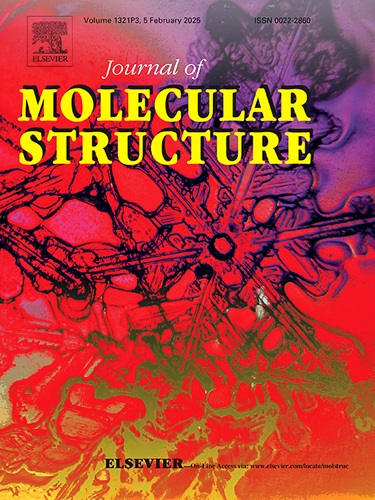绿色可持续合成用于信息加密的雏菊荧光碳点
IF 4
2区 化学
Q2 CHEMISTRY, PHYSICAL
引用次数: 0
摘要
本文报道了一种可持续、环保的绿色荧光碳点(G-CDs)的合成方法,该方法是由一种常见的蔬菜雏菊和邻苯二胺通过水热法合成的。利用各种光谱技术对合成的G-CDs进行了全面表征,发现最大激发波长为436 nm,发射波长为539 nm,在乙醇中的量子产率高达14.5%。系统地研究了G-CDs的光学性质,证明了其优异的耐盐性、pH稳定性和光稳定性。值得注意的是,G-CDs表现出与激发无关的发射行为,表明其荧光发射中心为单一类型。通过在紫外线照射下生成清晰的二维码图案,展示了g - cd作为防伪油墨的实际应用,展示了其在信息加密和防伪方面的潜力。这项工作不仅为G-CD的合成提供了可持续和经济的方法,而且突出了其在光学防伪和信息加密领域的广阔前景。本文章由计算机程序翻译,如有差异,请以英文原文为准。
Green and sustainable synthesis of fluorescent carbon dots from crown daisy for information encryption application
Herein, we report a sustainable and eco-friendly synthesis of green fluorescent carbon dots (G-CDs) from crown daisy, a common vegetable, and o-phenylenediamine via a hydrothermal method. The synthesized G-CDs were comprehensively characterized using various spectroscopic techniques, revealing a maximum excitation wavelength of 436 nm and emission at 539 nm with a quantum yield of up to 14.5 % in ethanol. The optical properties was systematically investigated, demonstrating the excellent salt tolerance, pH stability, and photostability of the G-CDs. Notably, the G-CDs exhibited excitation-independent emissions behavior, indicating a single type of fluorescent emission center. The practical application of G-CDs as anti-counterfeiting ink was demonstrated by generating a clear QR code pattern under UV illumination, showcasing their potential for information encryption and anti-counterfeiting applications. This work not only provides a sustainable and cost-effective approach for G-CD synthesis but also highlights their promising prospects in optical anti-counterfeiting and information encryption domains.
求助全文
通过发布文献求助,成功后即可免费获取论文全文。
去求助
来源期刊

Journal of Molecular Structure
化学-物理化学
CiteScore
7.10
自引率
15.80%
发文量
2384
审稿时长
45 days
期刊介绍:
The Journal of Molecular Structure is dedicated to the publication of full-length articles and review papers, providing important new structural information on all types of chemical species including:
• Stable and unstable molecules in all types of environments (vapour, molecular beam, liquid, solution, liquid crystal, solid state, matrix-isolated, surface-absorbed etc.)
• Chemical intermediates
• Molecules in excited states
• Biological molecules
• Polymers.
The methods used may include any combination of spectroscopic and non-spectroscopic techniques, for example:
• Infrared spectroscopy (mid, far, near)
• Raman spectroscopy and non-linear Raman methods (CARS, etc.)
• Electronic absorption spectroscopy
• Optical rotatory dispersion and circular dichroism
• Fluorescence and phosphorescence techniques
• Electron spectroscopies (PES, XPS), EXAFS, etc.
• Microwave spectroscopy
• Electron diffraction
• NMR and ESR spectroscopies
• Mössbauer spectroscopy
• X-ray crystallography
• Charge Density Analyses
• Computational Studies (supplementing experimental methods)
We encourage publications combining theoretical and experimental approaches. The structural insights gained by the studies should be correlated with the properties, activity and/ or reactivity of the molecule under investigation and the relevance of this molecule and its implications should be discussed.
 求助内容:
求助内容: 应助结果提醒方式:
应助结果提醒方式:


